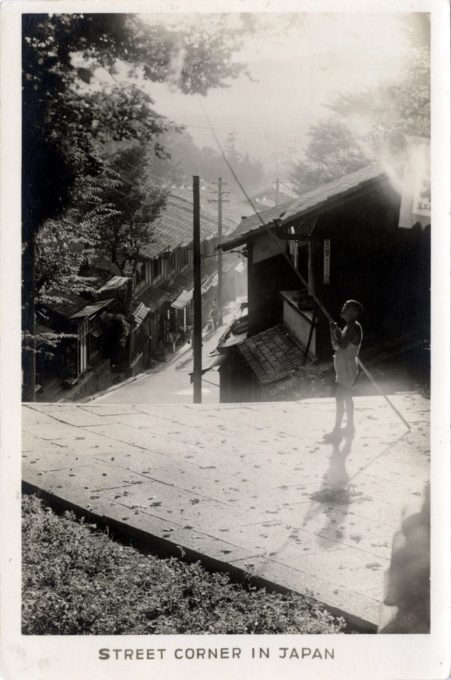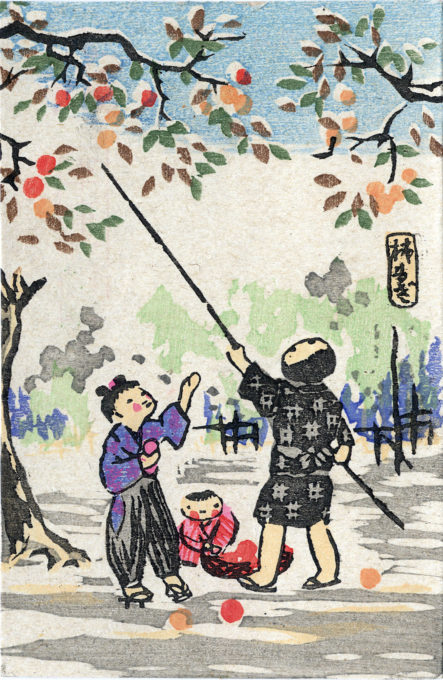“Persimmon juice and lacquer are two ingredients of art paint that come from Japan; and these products have no parallel in other countries. Persimmon juice is especially useful for mixing paint in damp countries, of which Japan is one. Yet the use of persimmon juice in paint is hardly known at all in western countries.
“[P]ersimmon juice [is also used] as an adhesive material for making sacks , as , unlike other kinds of starch , it does not soften with the heat. For this purpose persimmon juice is much better than gum Arabic . In Japan persimmon juice is a very valuable ingredient in making packing paper, pasting umbrellas, raincoats and paper boxes, making waterproof bags, insect paper, cloth of various kinds, and for producing a gloss on silk, tortoiseshell and other smooth surfaces.
“It is always used as an undercoating in lacquer painting, for which it is indispensable and used as an undercoating in dyeing leather it works admirably, causing the material to keep its colour well. It has the wonderful property of being proof against both water and heat, and therefore it is very valuable in all material used for wrapping explosives.
“In painting ship’s bottoms, too, persimmon juice is invaluable, as well as for coating pattern paper. It is also used with good effect in paint for buildings, and in all paper used to protect goods from moisture. As paper covered with persimmon juice is insect-proof it is used much in rural districts for rice bags and bags for other grains. Brewers also use it to recover the taste of saké once the flavour is lost, for which it works admirably.
“Having so many valuable qualities it is remarkable that persimmon juice is not better known and more used in western countries.
“… As the persimmon tree flourishes all over Japan the source of supply can always meet the demand. The best trees grow in the warmer latitudes. The mode of extracting the juice from the fruit was for a long time rather primitive, but after the demand for it increased better modes of extraction were introduced.
“A scientific apparatus is now used for pressing the juice from the fruit of the tree, some that like the cider press of America. There is a very general conviction among men of science and men of commerce in this country that persimmon juice will soon come to be in general demand for mixing paints, and then the trade in Japan will be very extensive in this product.”
– “A Revolution in Pigments”, by K. Nakai, The Japan Magazine, October 1919

“Street corner in Japan,” c. 1950. A young boy uses a long bamboo pole to pick persimmons from a village tree.
“The story of ‘The Monkey and the Crab has as many versions as that of ‘The Arkansas Traveler.’ It is continually re-appearing in new dress and with new variations, according to the taste and abilities of the audience. Its flavor, as told by the chaste mother instructing her daughters, or by the vulgar coolie amusing his fellow-loafers while waiting for a job, is vastly different in either case. The most ordinary form of the story is as follows:
“Once upon a time, a monkey and a crab went for a walk.
“Along the way, the monkey found a persimmon seed and the crab found a rice ball. The sly monkey persuaded the crab to trade his rice ball for the persimmon seed, and quickly ate the rice ball.
“The disappointed crab couldn’t eat the persimmon seed, but she took it home and planted it in her garden, where she tended it until it grew into a large tree full of beautiful persimmons. When the monkey saw this, he climbed the tree and began to eat them. The crab asked him to pick some for her, but he threw down only a hard green persimmon, which hit the crab on the head and hurt her badly.
“The crab’s children were very distressed to see their mother hurt. Their friends, a bee, a chestnut and a mortar came to see their mother. They asked them to help take revenge on the monkey. To do this, they invited the monkey to their house.
“When he sat down by the fireplace, the chestnut burst out from the ashes and burnt him. As he reached for the water jug, the bee flew out of it and stung him. Then as he tried to run out of the house, the mortar fell on him from above the door and squashed him.
“The monkey saw there was no escape. He apologised to the crab for hurting her, to the delight of the children and their friends. The monkey had learned his lesson and never again tried to cheat anyone.”
– The Mikado’s Empire, by William Elliot Griffis, 1906


